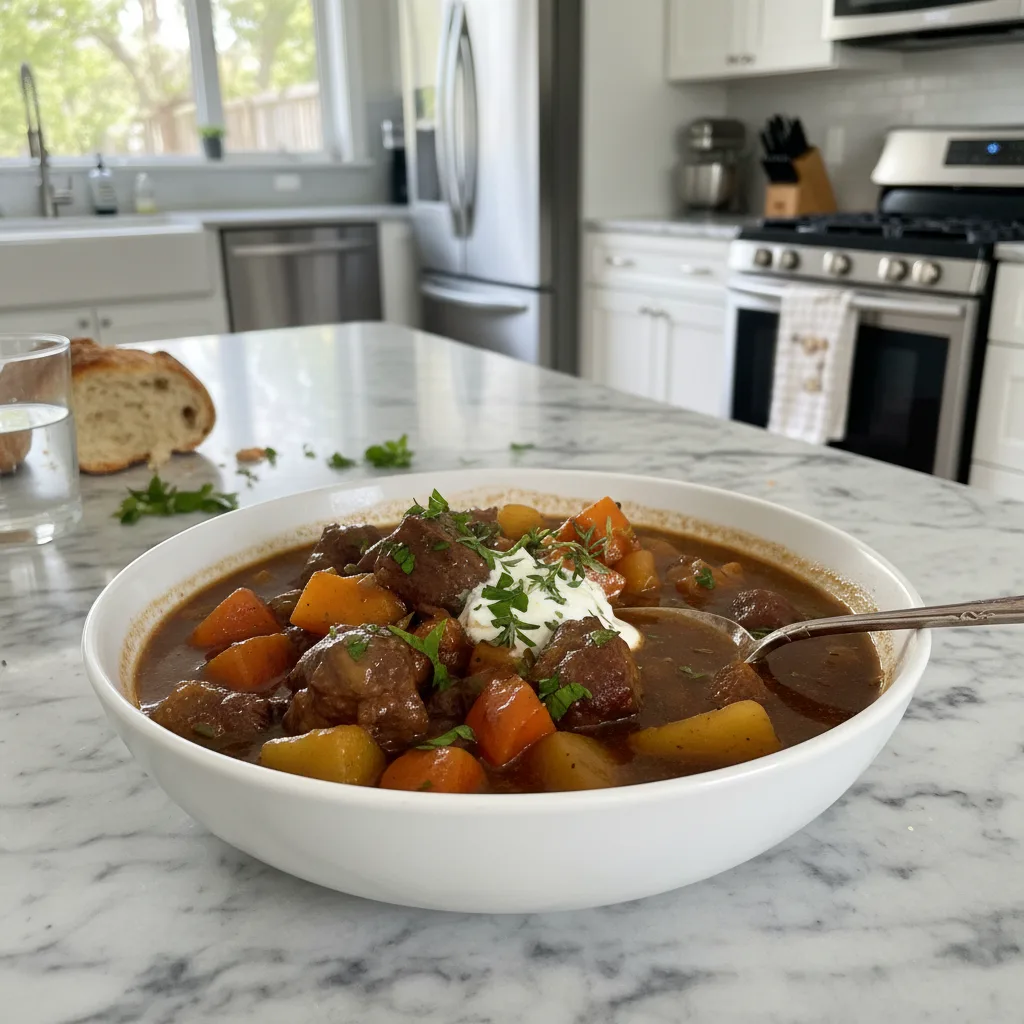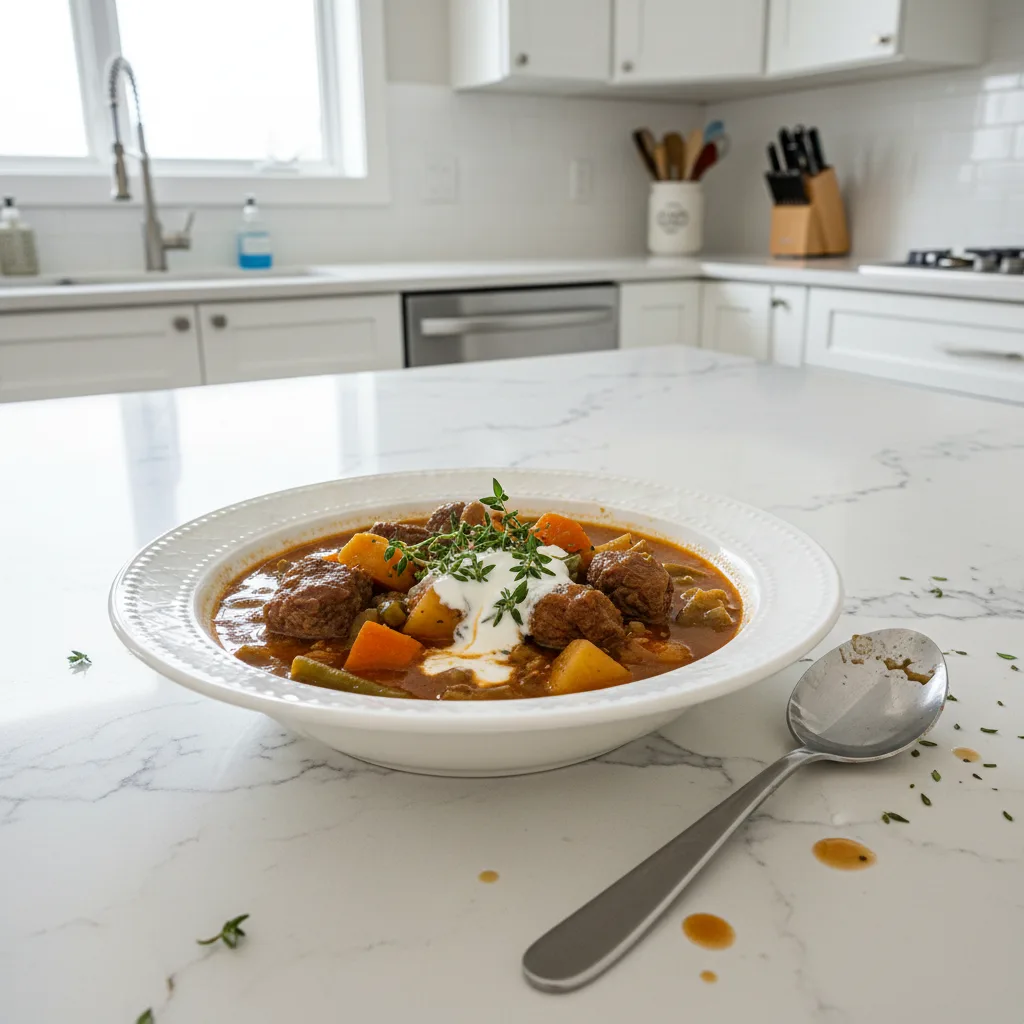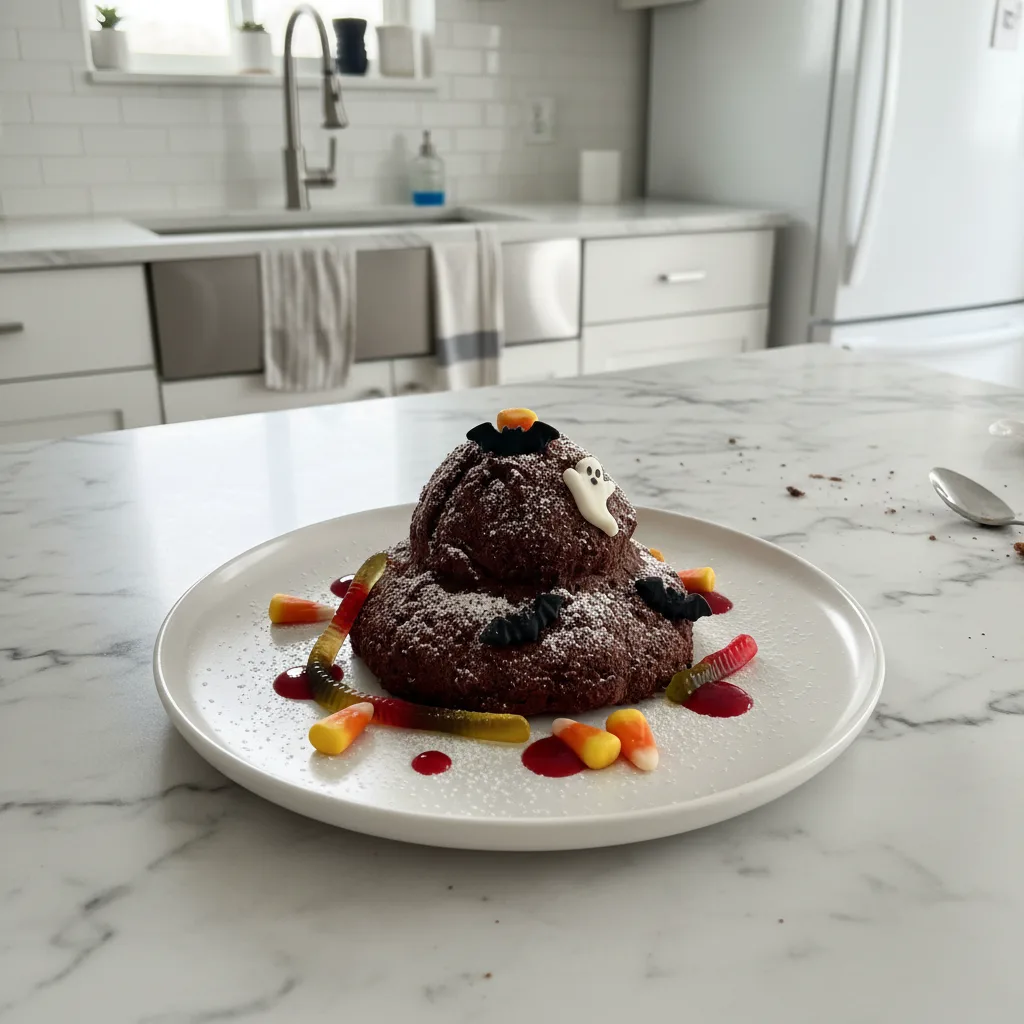There’s this memory I have, a crisp autumn evening, leaves crunching underfoot, and the smell of something utterly wonderful wafting from my grandmother’s kitchen. That was my first introduction to what I now call my Autumn Harvest Beef Stew. I was just a little sprout, honestly, probably more interested in chasing fireflies, but that aroma? It snagged me. I remember peering over the counter, a little confused by all the chopping, but that bubbling pot, it felt like magic. It’s a dish that just screams ‘home’ to me, a warm hug when the days get shorter and the air turns chilly.
I swear, one time I was so excited to get this simmering, I completely forgot to brown the beef first. Just dumped everything in! Oops. It still tasted good, because, well, stew, but the beef just didn’t have that lovely crust. Lesson learned: don’t rush the browning, hon. It makes a real difference in the flavor depth. My kitchen was a bit of a chaotic mess that day, but hey, that’s real cooking, right?
Ingredients for Autumn Harvest Beef Stew
- Chuck Roast: This is the star! You need a good, fatty cut for tenderness. Don’t go lean, trust me. I tried that once and it was like chewing on shoe leather. Just don’t.
- Carrots & Celery: The classic mirepoix starting point. They add sweetness and a savory backbone. Honestly, I always chop a bit extra of each for snacking while I cook.
Yellow Onion: Essential for depth. More garlic, less salt, always my motto. Freshly chopped, please, those frozen pre-chopped ones just don’t hit the same.
Potatoes (Yukon Gold or Red): They soak up all that glorious broth. I once used russets and they turned to mush, a total kitchen disaster. Stick with waxy varieties for structure.
Beef Broth (Low Sodium): The liquid gold! I recommend a good quality low-sodium one so you can control the seasoning. I remember once grabbing regular broth and my stew was so salty, I had to add a whole extra cup of water to balance it out. Oops!
- Tomato Paste: A secret weapon for umami. A small tube is great because you can save the rest. It adds a richness you just can’t get otherwise.
- Red Wine (Dry, e.g., Cabernet Sauvignon): This is where the magic happens, adding a complex layer of flavor. Don’t use anything you wouldn’t drink, but also, don’t break the bank!
- Fresh Thyme & Rosemary: These herbs just scream “autumn.” Fresh is absolutely key here, dried just can’t compare, honestly. The smell alone is half the experience.
- Garlic: Lots of it! Minced, not powdered. I usually double what any recipe calls for. What can I say, I’m a garlic girl.
- All-Purpose Flour: Helps thicken the stew. Just a little dusting helps create that lovely rich sauce.
- Bay Leaves: Subtle, but they make a difference. Don’t forget to take them out before serving! I’ve had a few close calls there, haha.
- Salt & Black Pepper: Season generously, tasting as you go. This is where you make it yours.
How to Make Autumn Harvest Beef Stew
- Prep the Beef:
- First things first, pat that chuck roast dry with paper towels. I mean really dry, hon, this helps with browning. Then, cut it into nice 1-inch cubes. You want them somewhat uniform so they cook evenly. Season them generously with salt and pepper. This is where I sometimes get a little heavy-handed, but for stew, it works! The smell of the seasoned beef already gets me excited.
- Sear the Meat:
- Heat a couple tablespoons of olive oil in a large Dutch oven or heavy-bottomed pot over medium-high heat. When it’s shimmering, add the beef in batches. Don’t crowd the pan! This is where I always get impatient and try to do it all at once, and then the beef steams instead of browns. Oops. Let it get a beautiful golden-brown crust on all sides, then remove to a plate. That crust is flavor, my friend!
- Sauté Aromatics:
- Reduce the heat to medium. Add a bit more oil if needed, then toss in your chopped onions, carrots, and celery. Sauté them for about 5-7 minutes until they start to soften and smell absolutely divine. This is the foundation of the dish, and the aroma filling the kitchen is just chef’s kiss! Don’t let them brown too much, just get them tender.
- Build the Flavor:
- Stir in the minced garlic and tomato paste, cooking for another minute until fragrant. Then, sprinkle in the flour and stir for about a minute to cook off that raw flour taste. This step is super important for thickening. Now, pour in the red wine, scraping up all those delicious browned bits from the bottom of the pot. Let it simmer for a couple of minutes until it’s reduced a bit. I once skipped the wine, and it just wasn’t the same, trust me on this one.
- Simmer the Stew:
- Return the seared beef to the pot. Pour in the beef broth, add the fresh thyme, rosemary, and bay leaves. Bring it to a gentle simmer, then reduce the heat to low, cover, and let it cook for at least 2 hours. This is where patience pays off! The beef will start to get wonderfully tender. I always peek in too early, but resist the urge for at least an hour!
- Add Veggies & Finish:
- After 2 hours, stir in your chopped potatoes. Continue to simmer, covered, for another 30-45 minutes, or until the potatoes are fork-tender and the beef is falling apart. Taste and adjust seasoning as needed. You want that broth to be rich and flavorful. The final Autumn Harvest Beef Stew should be thick, fragrant, and just begging to be devoured. Remove the bay leaves before serving, obviously!
Honestly, there are days when my kitchen looks like a tornado just ripped through it, but putting a pot of this on the stove? It just calms everything down. The smells that start to fill the house, that deep, rich aroma, it’s like a warm hug. It makes all the little chopping mishaps and flour dustings worth it. This stew isn’t just food, it’s a feeling, you know?
Storage Tips for Autumn Harvest Beef Stew
This Autumn Harvest Beef Stew is even better the next day, I swear! Let it cool completely before transferring it to an airtight container. I’ve made the mistake of putting warm stew in the fridge, and it just creates condensation, which can make things a bit watery. Don’t do that lol. It holds up beautifully in the fridge for 3-4 days. For longer storage, this stew freezes like a dream! Portion it into freezer-safe containers or bags, leaving a little headspace for expansion. It’ll keep for up to 3 months. To reheat, thaw overnight in the fridge and then gently warm on the stovetop over low heat, or in the microwave. Sometimes the sauce separates a tiny bit after freezing, but a good stir usually brings it right back together. My personal tip? Add a splash of fresh broth or water when reheating if it seems too thick.

Autumn Harvest Beef Stew Ingredient Substitutions
Life happens, and sometimes you don’t have exactly what the recipe calls for. I get it! For the chuck roast, you could try stew meat, but make sure it’s a cut meant for slow cooking. I tried using sirloin once, and it was tough, so learn from my mistake! If you’re out of red wine, a good dark beer (like a stout or porter) works wonders and adds a different, delicious depth, I tried it once when I ran out of wine and it worked… kinda, it was definitely different but still good! Feel free to swap out the potatoes for sweet potatoes for a touch of sweetness, or even parsnips for an earthy flavor. If you don’t have fresh herbs, use dried, but remember that dried herbs are more potent, so use about a third of the amount. A dash of Worcestershire sauce can also boost that umami if you’re feeling fancy or missing some depth.
Serving Suggestions for Autumn Harvest Beef Stew
Oh, the possibilities! This Autumn Harvest Beef Stew is a meal in itself, but it loves a good companion. I usually serve it with a crusty baguette for soaking up all that incredible broth honestly, it’s a must. A simple green salad with a bright vinaigrette cuts through the richness beautifully. For a heartier side, creamy mashed potatoes or even some egg noodles are just divine. And for drinks? A robust red wine (maybe the same one you cooked with!) or a dark ale pairs perfectly. This dish and a cozy blanket, a good book, or a rom-com? Yes please. It’s the kind of meal that makes you want to slow down and savor every bite, especially on a chilly evening. Sometimes I even sprinkle a bit of fresh parsley over the top for a pop of color, it makes it feel extra special.
Cultural Backstory of Autumn Harvest Beef Stew
Beef stew, in its essence, is a dish found in countless cultures, born from the need to make tough cuts of meat tender and flavorful through long, slow cooking. This version, with its root vegetables and hearty beef, really echoes the traditions of European peasant cooking, where seasonal produce and affordable cuts were transformed into nourishing meals. For me, this particular version feels deeply connected to my grandmother’s kitchen, a blend of her Irish-American roots and whatever seasonal goodness she could find at the local market. It wasn’t about fancy ingredients, but about love and making the most of what you had. It became our family’s go-to when the leaves started to turn, a symbol of gathering and warmth. It’s a dish that carries generations of comfort in every spoonful.
And there you have it, my dear friend. This Autumn Harvest Beef Stew, bubbling away on the stove, filling your home with the most incredible smells. It’s more than just a recipe, it’s a little piece of comfort, a reminder of crisp evenings and good company. I hope it brings as much warmth and joy to your table as it does to mine. Honestly, seeing that rich, dark broth and fork-tender beef just makes me happy. Don’t forget to tell me how your version turns out!

Frequently Asked Questions About Autumn Harvest Beef Stew
- → Can I make this stew in a slow cooker?
Absolutely! After browning the beef and sautéing the aromatics on the stovetop (don’t skip this for flavor!), combine everything in your slow cooker. Cook on low for 6-8 hours or high for 3-4 hours. It’s a lifesaver on busy days, trust me!
- → What if I don’t have red wine?
No worries! You can substitute with an equal amount of beef broth, or even a dark beer like Guinness for a richer, malty flavor. I’ve tried both, and while the wine adds a unique depth, broth works just fine!
- → Why is my beef still tough?
Ah, the classic stew dilemma! It usually means it hasn’t cooked long enough. Beef chuck needs time, sometimes up to 3 hours or more, to really break down and become tender. Just keep simmering, it’ll get there!
- → How can I thicken my stew if it’s too thin?
If it’s too thin after cooking, you can make a slurry! Mix a tablespoon of flour or cornstarch with an equal amount of cold water, then slowly stir it into the simmering stew. Let it cook for a few minutes to thicken. Works like a charm!
- → Can I add other vegetables?
Oh, please do! That’s the beauty of stew. Parsnips, turnips, mushrooms, or even a handful of green beans towards the end are all fantastic additions. Experiment and make it your own, I often throw in whatever veggies are hanging out in my fridge!

Hearty Autumn Harvest Beef Stew: A Sunday Supper Classic
- Prep Time: 20 Minutes
- Cook Time: 3 Hours
- Total Time: 3 Hours 20 Minutes
- Yield: 6 Servings 1x
- Category: Tasty Recipes
Description
Warm up with my rustic Autumn Harvest Beef Stew! Tender beef, root veggies, and rich broth make this a soul-satisfying meal.
Ingredients
- Main Stew Components:
- 2–3 lbs chuck roast, trimmed and cut into 1-inch cubes
- 2 large carrots, peeled and chopped
- 2 celery stalks, chopped
- 1 large yellow onion, chopped
- 1.5 lbs potatoes (Yukon Gold or red), peeled and cut into 1-inch cubes
- 4 cups low-sodium beef broth
- 1 cup dry red wine (e.g., Cabernet Sauvignon)
- 2 tbsp tomato paste
- Aromatics & Seasonings:
- 1 tbsp olive oil
- 4 cloves garlic, minced
- 2 sprigs fresh thyme
- 1 sprig fresh rosemary
- 2 bay leaves
- 1 tsp salt, or to taste
- 1/2 tsp black pepper, or to taste
- Thickening Agent:
- 2 tbsp all-purpose flour
Instructions
- Prep the Beef:: First things first, pat that chuck roast dry with paper towels. I mean really dry, hon, this helps with browning. Then, cut it into nice 1-inch cubes. You want them somewhat uniform so they cook evenly. Season them generously with salt and pepper. This is where I sometimes get a little heavy-handed, but for stew, it works! The smell of the seasoned beef already gets me excited.
- Sear the Meat:: Heat a couple tablespoons of olive oil in a large Dutch oven or heavy-bottomed pot over medium-high heat. When it’s shimmering, add the beef in batches. Don’t crowd the pan! This is where I always get impatient and try to do it all at once, and then the beef steams instead of browns. Oops. Let it get a beautiful golden-brown crust on all sides, then remove to a plate. That crust is flavor, my friend!
- Sauté Aromatics:: Reduce the heat to medium. Add a bit more oil if needed, then toss in your chopped onions, carrots, and celery. Sauté them for about 5-7 minutes until they start to soften and smell absolutely divine. This is the foundation of the dish, and the aroma filling the kitchen is just *chef’s kiss*! Don’t let them brown too much, just get them tender.
- Build the Flavor:: Stir in the minced garlic and tomato paste, cooking for another minute until fragrant. Then, sprinkle in the flour and stir for about a minute to cook off that raw flour taste. This step is super important for thickening. Now, pour in the red wine, scraping up all those delicious browned bits from the bottom of the pot. Let it simmer for a couple of minutes until it’s reduced a bit. I once skipped the wine, and it just wasn’t the same; trust me on this one.
- Simmer the Stew:: Return the seared beef to the pot. Pour in the beef broth, add the fresh thyme, rosemary, and bay leaves. Bring it to a gentle simmer, then reduce the heat to low, cover, and let it cook for at least 2 hours. This is where patience pays off! The beef will start to get wonderfully tender. I always peek in too early, but resist the urge for at least an hour!
- Add Veggies & Finish:: After 2 hours, stir in your chopped potatoes. Continue to simmer, covered, for another 30-45 minutes, or until the potatoes are fork-tender and the beef is falling apart. Taste and adjust seasoning as needed. You want that broth to be rich and flavorful. The final Autumn Harvest Beef Stew should be thick, fragrant, and just begging to be devoured. Remove the bay leaves before serving, obviously!








